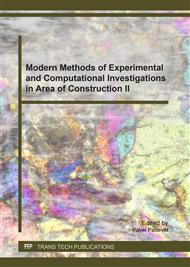p.48
p.54
p.59
p.65
p.70
p.76
p.81
p.88
p.97
Utilization of Plasma Treated Polymeric Macro-Fibers as Reinforcement in Concrete Constructions
Abstract:
Polymeric macro fibers BeneSteel having diameter equal to 480 μm and length 55 mm were treated in low pressure oxygen plasma by different treatment duration from 5 to 480 s to attain the better interaction with cement matrix (focused on both, chemical and physical bond). An effect of realized treatment was examined through fiber surface water wettability observation by direct horizontal optical method enabling contact angle measurements. Next, the pertinent negative impact of plasma treatment on fibers mechanical properties was examined by several methods. It was shown that the most effective plasma treatment duration is up to 30 s. Thus treated fibers exhibited the better wettability by ca. 110 % in comparison with reference fibers, while its mechanical properties were not negatively affected. Finally, reference and 30 s plasma treated fibers were used as randomly dispersed reinforcement in concrete specimens. Mechanical properties of these composites were examined by four-point bending tests. Specimens containing treated fibers exhibited bigger fracture toughness by ca. 30 % beside the reference ones, while the first cracking strength stayed constant in all cases.
Info:
Periodical:
Pages:
70-75
Citation:
Online since:
March 2017
Authors:
Price:
Сopyright:
© 2017 Trans Tech Publications Ltd. All Rights Reserved
Share:
Citation:


